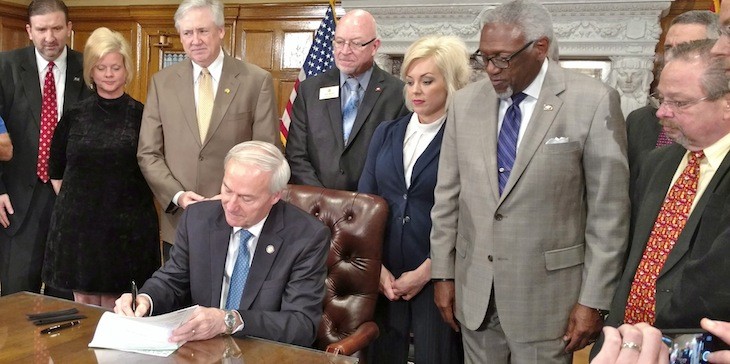Governor signs higher ed funding bill into law, calls legislation ‘landmark change’
by February 8, 2017 6:35 pm 533 views

Gov. Asa Hutchinson on Wednesday (Feb. 8) checked off another item on his legislative “to-do list” when he signed a bill into law he said will improve accountability at the state’s colleges and universities by changing the funding formula to focus on student progress rather than enrollment levels.
“I had some priorities in this legislative session, and one of those priorities is the higher education productivity funding formula,” Hutchinson said during a bill signing ceremony at the Governor’s Conference Room. “As you know, I take seriously the objectives we set as a state. It’s a challenge for us, but it is an important objective to increase the degree and certificate attainment.”
Under House Bill 1209, now Act 148, the state’s new formula would base funding on the institutions’ success in advancing students. The previous formula was based on numerical enrollment and infrastructure costs. The key metric, the governor said, is to increase the percentage of Arkansans who attain post-secondary degrees from 40% to 60% by 2025.
“In order to accomplish that, we really have to get higher education funding right,” Hutchinson said with state Department of Higher Education (DHE) Director Dr. Maria Markham at his side.
The new model would also provide funding based on credentials awarded, student progression toward degrees, time to degree, and other factors. More funding would be awarded for students enrolled in math and science and other high-demand majors, as well as students coming from challenging circumstances. Each student would be worth a certain amount of points.
In addition, the model would cap across-the-board higher education funding increases or decreases at 2% per year. An institution could lose no more than 2% a year but could gain more. Funding changes would be based on three-year rolling averages.
NO MORE ‘BUSINESS AS USUAL’
During the bill signing ceremony at the State Capitol, Hutchinson thanked Markham for spearheading the effort in pushing one of the governor’s key education initiatives through the legislature in the fifth week of the 2017 general session. Hutchinson added that the funding formula will lead to dramatic shifts in policy at the state’s institutions of higher education, calling Act 148 a “landmark change” for the state.
“It’s changing it from simply doing it as ‘business as usual’ in this state, and doing funding based on per student formulas or just because it is the same funding we had last year to say ‘we can do it better as a state and we can reward excellence and reward universities and institutions that are accomplishing student progression,’” the governor said.
During the bill signing ceremony, the governor was joined by House and Senate bill sponsors Rep. Mark Lowery, R-Maumelle, and Sen. Eddie Joe Williams, R-Cabot, and other Republican legislative leaders, including President Pro Tempore Jonathan Dismang of Beebe and Sen. Jane English of North Little Rock. Rep. George McGill, D-Fort Smith, was also at the signing.
State Department of Education Director Johnny Key, University of Arkansas System President Dr. Donald Bobbitt, Arkansas State University System President Dr. Charles Welch, and top state policymakers and college and university officials from across the state were also in attendance.
Still to be determined is a metric measuring post-completion success. Markham said policymakers and the Arkansas Higher Education Coordinating Board will begin meeting soon to begin drafting enabling regulations for Act 148. She said a “first draft” of the plan will be completed by April, and a final draft is expected to be completed for review by the governor and the legislature in August.
In response to questions from reporters, Markham said the board intends to adopt separate policies for two-year colleges and technical schools and four-year institutions based on their educational goals and needs. She said adjustments will be made for smaller colleges, which have higher administrative expenses, and research universities. According to language in the bill, the Education Department will review the policies every five years to ensure the productivity-based funding model continues to respond to the needs and priorities of the state.
‘EARLY CONCLUSION TO THE SESSION’ SOUGHT
Separately, Hutchinson applauded the legislative leadership for focusing on the state’s most significant needs and concerns during the first month of the session. He said lawmakers have also done a good job of not getting caught on “peripheral issues” that will lengthen the lawmakers’ stay in Little Rock.
“I am hopeful that the session keeps progressing this way, and that there will be an early conclusion to the session,” he said. “I think we will shift soon from substantive legislation that we have been working on – and there is still more to do – but we will be able to shift to the revenue stabilization act and preparations for that as well as really trying to hone in on the next biennium budget.”
Over the past week or so, Hutchinson has signed into law major parts of his $5.5 billion fiscal budget, including a $50.5 million tax cut for low-income workers and a $13.4 million income tax exemption for military retirees and their families.
At least a half-dozen bills that carry many of the governor’s key economic development and government efficiencies measures outlined ahead of the session are winding their way through both chambers of the General Assembly.
Hutchinson also said he was confident the state will be able to meet all of its obligations once the budget is completed. Last week, Hutchinson told state agency directors to develop contingency plans in the face of January’s dismal tax collections, which came in $47.1 million or 8.1% below forecast.
“I presented a balance budget, and we will look at it very carefully to see if there needs to be any adjustments to that,” the governor said. “I do still believe it is sound and I am very confident of where we are even though we are continuing to monitor the revenue picture …”
